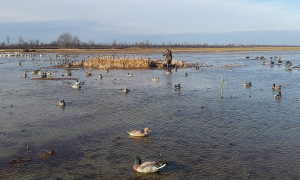 The right decoy strategy can turn a mediocre hunt into a productive one. But creating a convincing spread isn’t always easy, especially if the elements are working against you. If you’re planning a guided duck hunting trip, use these eight decoy strategies to pull in more ducks.
The right decoy strategy can turn a mediocre hunt into a productive one. But creating a convincing spread isn’t always easy, especially if the elements are working against you. If you’re planning a guided duck hunting trip, use these eight decoy strategies to pull in more ducks.
- Don’t Underestimate the Importance of Realism One thing experts can all agree on is that realism is so important when setting your spread. At Show Me Snow Geese, we know just how important it is to have realistic decoys. Today’s plastic decoys have incredibly realistic paint schemes that are just as detailed as the plumage of real live ducks. If you would like to go a step further, flocked decoys are a nice choice and are particularly effective on cloudy days. Of course, premium decoys tend to be the most effective and often include ducks in different positions. You may also want to add some sleeper, feeder and rester decoys to really create the illusion of a live flock.
- Don’t Forget the Coot Decoys If you’re a seasoned hunter, you’ve probably spent quite a bit of time observing ducks and their behavior. You know that coots often congregate with dabblers while they’re feeding; rarely do they eat alone. To create a realistic spread, add coot decoys along the edge of the bank. This is where you’d see them feeding naturally and what dabblers expect to see, so they’ll drop right in without even circling.
- Break Up Large Diver Spreads If you’re setting up a large spread on open water, gang-rigging is your best option. But these spreads tend to look unrealistic from up in the air. Break up your spread by first setting your longlines and then adding a few dozen decoys in between them. For good measure, supplement your spread with swan decoys to attract dabbling ducks.
- Make Sure Your Spread is Visible Setting a decoy spread in a prime resting or feeding area is smart, but it’s not always necessary. On cold and windy days or when large numbers of birds are in flight, a hunt can be just as productive if a spread is set in an area where the ducks can see it. Remember, visibility is the key. If the ducks can’t see it, they won’t decoy.
- The More Decoys You Have, the Better Can you ever have too many decoys? Probably not. The more decoys you put out, the more ducks you’ll pull in. While larger spreads with hundreds of decoys can be expensive and time consuming to put together, they tend to pay off in terms of how many ducks you pull in.
- Attract Dabblers with Muddy Decoys If you’re hunting in flooded fields and timber, muddying up the water will help attract dabblers. When real ducks feed in these areas, they tend to kick up mud off the bottom. Some experts recommend simulating this by driving a four-wheeler through the decoys to kick up some mud. Ducks, being greedy birds, will have a hard time resisting if they think they see other ducks feeding.
- Create Movement Movement in a decoy spread can grab the attention of passing ducks. Jerk string can be used to create ripples in the water, but some hunters keep it simple by kicking the water to create movement. It also helps to set decoys in spots where they might catch some wind or ride along the current.
- Don’t Set Up the Same Spread Twice Ducks get accustomed to seeing the same spreads along the flyway as the season progresses. Make sure your spread is different, so you attract the flock’s attention as it flies by. Consider adding full-bodied decoys, resters, sleepers, headless feeders and surface feeders into the mix. Don’t be afraid to add some goose floaters too, especially if you’re hunting late in the season. Some ducks, mallards especially, feel safer around geese.






